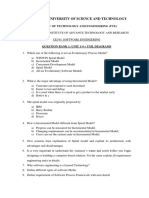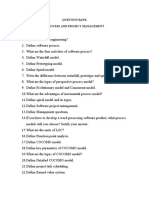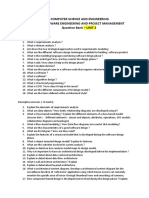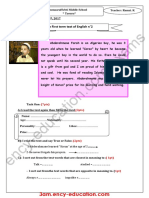0 ratings0% found this document useful (0 votes)
6 viewsShort Ans SE
Short Ans SE
Uploaded by
MD ARIFSE( software engineering)
Copyright:
© All Rights Reserved
Available Formats
Download as DOCX, PDF, TXT or read online from Scribd
Short Ans SE
Short Ans SE
Uploaded by
MD ARIF0 ratings0% found this document useful (0 votes)
6 views2 pagesSE( software engineering)
Copyright
© © All Rights Reserved
Available Formats
DOCX, PDF, TXT or read online from Scribd
Share this document
Did you find this document useful?
Is this content inappropriate?
SE( software engineering)
Copyright:
© All Rights Reserved
Available Formats
Download as DOCX, PDF, TXT or read online from Scribd
Download as docx, pdf, or txt
0 ratings0% found this document useful (0 votes)
6 views2 pagesShort Ans SE
Short Ans SE
Uploaded by
MD ARIFSE( software engineering)
Copyright:
© All Rights Reserved
Available Formats
Download as DOCX, PDF, TXT or read online from Scribd
Download as docx, pdf, or txt
You are on page 1of 2
1) What is the prime objective of software engineering?
2) Define software engineering paradigm.
3) What do you mean by spiral model?
4) Write a brief note on waterfall model.
5) Distinguish between process and methods.
6) Give the importance of software engineering.
7) Define software process. State the important features of a process.
8) Write any two characteristics of software as a product.
9) List the process maturity levels in SEI' s CMM.
10) Distinguish clearly between verification & validation.
11) What are the functions of data architecture?
12) Define System Modeling.
13) State the System Engineering Hierarchy.
14) Mention some of the factors to be considered during System Modeling.
15) What are the different architectures developed during BPE?
16) Define Verification &Validation.
17) Mention any two non-functional requirements on software to be developed
18) What is known as SRS review? How is it conducted?
19) Distinguish between expected requirements and excited requirements
20) What is meant by software prototyping?
21) What are the non-functional requirements of software?
22) Write the distinct steps in requirements engineering process?
23) Compare evolutionary and throw away prototyping?
24) What is the role of data dictionary?
25) Write a brief note on data modeling activity?
26) What is meant by Information flow Continuity?
27) Define Behavioral Modeling.
28) What is meant by Throw away Prototyping?
29) What do you mean by horizontal and vertical partitioning?
30) How do you evaluate user interface?
31) Why software architecture is important in a software process? Distinguish between horizontal and
vertical partitioning?
32) How reliability is related to quality assurance?
33) Distinguish between horizontal and vertical partitioning?
34) What is the software architecture?
35) Compare data flow oriented design and data structured oriented design
36) What is the role of verification during a software exercise?
37) Distinguish between hard and soft real time systems.
38) Distinguish between product and process metrics.
39) What do you mean by reuse of design and update of a design as per technology changes and customer
psychology?
40) What is the work product of software design process and who does this?
41) Enumerate different data flow architectures
42) How do you describe software interface?
43) How the requirements are collected for user interface of software?
44) What is transaction mapping? How it is used in software design?
45) What are the various models produce by the software design process?
46) What is the quality parameters considered for effective modular design?
47) What is stress testing?
48) State the objectives and guidelines for debugging.
49) Distinguish between verification and validation:
50) What are the roles of testing tools?
51) What do you mean by test case management?
52) Distinguish between alpha and beta testing?
53) What are the approaches of debugging?
54) What are the roles of cyclomatic complexity value in software resting?
55) What is the need for cyclomatic complexity?
56) Distinguish between black and white box testing:
57) What is white box testing and what is the difficulty while exercising it?
58) Why testing is important with respect to software?
59) Define black box testing strategy?
60) What is static and dynamic testing?
61) How regression and stress tests are performed?
62) Write short notes on equivalence partitioning?
63) Write the types of system tests?
64) List out the importance of cost estimation in software development.
65) Mention the advantages of CASE tools.
66) How do you estimate time required for a software development project?
67) Draw the structure of CASE REPOSITORY and explain.
68) What is meant by software change?
69) Write short notes on empirical estimation models.
70) Why the software needs maintenance?
71) Define software re-engineering.
72) List any 4 categories of CASE tools.
73) What is Delphi cost estimation technique?
74) What is CASE?
75) What are software engineering layers?
76) Write about process assessment.
77) Define procedural interfaces.
78) Discuss about requirements validation in brief.
79) What is UML? Write the principles of modeling.
80) Give an example of a class diagram.
81) Define white-box testing and black –box testing.
82) How debugging differs from testing?
83) What is software risk?
84)
You might also like
- Integrated Chinese Lesson 8 Dialogue 2 - Lesson Plans PowerPoint Presentation Slides (听说读写PPT教案)Document299 pagesIntegrated Chinese Lesson 8 Dialogue 2 - Lesson Plans PowerPoint Presentation Slides (听说读写PPT教案)KamitoNo ratings yet
- GRED HD 01.06 User ManualDocument104 pagesGRED HD 01.06 User ManualAbrahamAlatriste100% (2)
- Software Engineering Question BankDocument10 pagesSoftware Engineering Question BankakshaylikeNo ratings yet
- MENQOLDocument8 pagesMENQOLarief_widya-pNo ratings yet
- Sap S4hana Data Migration PDFDocument20 pagesSap S4hana Data Migration PDFHussain Lalji100% (1)
- Mc9233 Software EngineeringDocument10 pagesMc9233 Software EngineeringnovfelnawzinNo ratings yet
- SE Question Bank-1Document2 pagesSE Question Bank-1samacc0907No ratings yet
- QuesDocument3 pagesQuesMD ARIFNo ratings yet
- SE - 2011 - 2nd EditionDocument9 pagesSE - 2011 - 2nd EditionRam GopalNo ratings yet
- SOTWARE ENGINEERING-case Tools LabDocument2 pagesSOTWARE ENGINEERING-case Tools Labmuhammadkamran05100% (1)
- SE QuestionBankDocument12 pagesSE QuestionBanksharmadhruv2808No ratings yet
- Question BankDocument11 pagesQuestion Bankjain100% (2)
- Se QBDocument6 pagesSe QBpriyajv14No ratings yet
- SE QuestionsDocument3 pagesSE QuestionsGouthami JukantiNo ratings yet
- Software Engineering QBDocument6 pagesSoftware Engineering QBKarthick ThiyaguNo ratings yet
- SE Que Lis 160701Document5 pagesSE Que Lis 160701has_meceNo ratings yet
- Se QBDocument11 pagesSe QBBrad WarrenNo ratings yet
- Question Bank Software EngineerningDocument9 pagesQuestion Bank Software EngineerningZaheer AbbasNo ratings yet
- SPM QB-1 (E-Next - In)Document2 pagesSPM QB-1 (E-Next - In)addk572No ratings yet
- AssinmentDocument2 pagesAssinmentvolatility75sNo ratings yet
- Kings: Cs1301 Software Engineering 1Document5 pagesKings: Cs1301 Software Engineering 1Nandini PriyankaNo ratings yet
- CS1301 Software EngineeringDocument5 pagesCS1301 Software EngineeringSathiya RajNo ratings yet
- PDDDocument5 pagesPDDSimbhu Ashok CNo ratings yet
- SWENGGG QBankDocument6 pagesSWENGGG QBankKarthick ThiyaguNo ratings yet
- SE QB - 2011 - 1st EditionDocument21 pagesSE QB - 2011 - 1st EditionDhanaraj ShanmugasundaramNo ratings yet
- S.E Final Q.BDocument5 pagesS.E Final Q.BbhagyashribbsccsNo ratings yet
- Se Important Questions R22Document4 pagesSe Important Questions R22patelpaone999No ratings yet
- Question Bank Unit 3 SepmDocument1 pageQuestion Bank Unit 3 SepmAKASH V (RA2111003040108)No ratings yet
- Software Engineering, DBMS, Scripting QuestionDocument20 pagesSoftware Engineering, DBMS, Scripting QuestionNeuz BadxhahNo ratings yet
- Important Objecive Questions.Document2 pagesImportant Objecive Questions.18R-317 Ashutosh pandaNo ratings yet
- Cse3050 SPM QB Mid TermDocument9 pagesCse3050 SPM QB Mid Termkishorekr2929No ratings yet
- SPM QBDocument2 pagesSPM QB8097161849aNo ratings yet
- 2 MarksDocument40 pages2 MarksmeenaprathapNo ratings yet
- IT2251 - Software Engineering and Quality Assurance - NoRestrictionDocument7 pagesIT2251 - Software Engineering and Quality Assurance - NoRestrictionrazithNo ratings yet
- Software Engineering - Assignment QuesDocument1 pageSoftware Engineering - Assignment QuesSangeeta Gupta 8bNo ratings yet
- SE Module Wise QuestionsDocument3 pagesSE Module Wise QuestionsVailantan FernandesNo ratings yet
- Software Project Management Question BankDocument4 pagesSoftware Project Management Question Bankheyefa5180No ratings yet
- Unit-3 Question BankDocument2 pagesUnit-3 Question Bankmalliilla59No ratings yet
- Question Bank 1-4Document6 pagesQuestion Bank 1-4Dhruvin KotakNo ratings yet
- Software Engineering QUESTION BANKDocument11 pagesSoftware Engineering QUESTION BANKHema MaheNo ratings yet
- 1271489378Document5 pages1271489378vidhya.dpi5566No ratings yet
- Se QbankDocument4 pagesSe QbankMohammad samiNo ratings yet
- MC1703 Software EngineeringDocument34 pagesMC1703 Software EngineeringVinoth KumarNo ratings yet
- Question Bank For MID-1Document2 pagesQuestion Bank For MID-1jvenuharsha22No ratings yet
- Ase QBDocument5 pagesAse QBfakeme9971No ratings yet
- SAP GRC AC FAQzDocument4 pagesSAP GRC AC FAQzgadesigerNo ratings yet
- Anna University Software Engineering Question BankDocument7 pagesAnna University Software Engineering Question BankJenifer MetildaNo ratings yet
- 2 Marks & 16 Marks Questions and Answers BA1739 - Software Development Part - ADocument19 pages2 Marks & 16 Marks Questions and Answers BA1739 - Software Development Part - AVaijayanth MKNo ratings yet
- Cs3co26 Software Engineering (T)Document16 pagesCs3co26 Software Engineering (T)bhavishNo ratings yet
- Section A There Are 4 Options To Every Question. Select The Correct Option. 1Document5 pagesSection A There Are 4 Options To Every Question. Select The Correct Option. 1PRINCE soniNo ratings yet
- Question Bank Unit 2 SepmDocument2 pagesQuestion Bank Unit 2 SepmAKASH V (RA2111003040108)No ratings yet
- Department of Computer Science and Engineering Academic Year - 2010 - 11 (Odd Semester)Document5 pagesDepartment of Computer Science and Engineering Academic Year - 2010 - 11 (Odd Semester)Harsha RoyalNo ratings yet
- SE Assignment QuestionsDocument2 pagesSE Assignment QuestionsKousheek MahendaranNo ratings yet
- Ooad Question BankDocument9 pagesOoad Question BanksivamseNo ratings yet
- BCA206 QB BCA 1yrDocument6 pagesBCA206 QB BCA 1yrpornisbad4healthNo ratings yet
- SE Important QuestionsDocument2 pagesSE Important Questionsd87522585No ratings yet
- Software Engineering Interview Questions and AnswersDocument12 pagesSoftware Engineering Interview Questions and Answersbk doseNo ratings yet
- What Is Software EngineeringDocument11 pagesWhat Is Software EngineeringRuchita YadavNo ratings yet
- SQA Question BankDocument4 pagesSQA Question BankShabbeer BashaNo ratings yet
- Big Data Question BankDocument15 pagesBig Data Question Bankkokiladevirajavelu0% (2)
- Mastering Software Engineering: From Basics to Expert ProficiencyFrom EverandMastering Software Engineering: From Basics to Expert ProficiencyNo ratings yet
- Foundations of Computing: Essential for Computing Studies, Profession And Entrance Examinations - 5th EditionFrom EverandFoundations of Computing: Essential for Computing Studies, Profession And Entrance Examinations - 5th EditionNo ratings yet
- Software Engineering New Approach (Traditional and Agile Methodologies)From EverandSoftware Engineering New Approach (Traditional and Agile Methodologies)No ratings yet
- BSS Word at Work Dec 2023Document36 pagesBSS Word at Work Dec 2023biblesocietysgNo ratings yet
- Narrative Writing SkillsDocument11 pagesNarrative Writing SkillsJanetNo ratings yet
- TPRS - My Personal StoryDocument2 pagesTPRS - My Personal StoryEnrique RojasNo ratings yet
- CCN Project ReportDocument11 pagesCCN Project ReportAbdul Basit IrfanNo ratings yet
- Makalah Bahasa Inggris 222 111Document9 pagesMakalah Bahasa Inggris 222 111cheese cakeNo ratings yet
- KTLTR Week02 PublishDocument52 pagesKTLTR Week02 PublishNhat LongNo ratings yet
- Grade 6 ShonaDocument22 pagesGrade 6 Shonakudzaimhene505No ratings yet
- Islam in The Bible - Thomas McElwain - XKPDocument199 pagesIslam in The Bible - Thomas McElwain - XKPIslamicMobility100% (1)
- Eagle DS - TALL-PRO-X - A4 - EN - LowresDocument2 pagesEagle DS - TALL-PRO-X - A4 - EN - Lowresyobeli7912No ratings yet
- Dzexams 3am Anglais d1 20180 1093360Document2 pagesDzexams 3am Anglais d1 20180 1093360fatiha0% (1)
- Vo IPDocument37 pagesVo IPD10 newsNo ratings yet
- Dzone Refcard 292 Advanced Kubernetes 2020 PDFDocument9 pagesDzone Refcard 292 Advanced Kubernetes 2020 PDFLeonardo Moreno ForeroNo ratings yet
- Contextualizing Cebuanong Bisaya Use and Vernacularization Research Edited MSU IITDocument17 pagesContextualizing Cebuanong Bisaya Use and Vernacularization Research Edited MSU IITAnnabeth ChaseNo ratings yet
- 2012 10 Microsoft Visual Basic 2010 Step by StepDocument576 pages2012 10 Microsoft Visual Basic 2010 Step by StepAngel Valles100% (1)
- Reviewer in English 8-Q4Document4 pagesReviewer in English 8-Q4katherine bacallaNo ratings yet
- Coal Modelling Tutorial Vision1Document78 pagesCoal Modelling Tutorial Vision1rusli geologistNo ratings yet
- Hantek6022be ManualDocument66 pagesHantek6022be ManualTrafu LarNo ratings yet
- Analogy Thesis StatementDocument6 pagesAnalogy Thesis StatementPaySomeoneToWriteMyPaperGilbert100% (2)
- Title Block Editor Catia Eng v5Document49 pagesTitle Block Editor Catia Eng v5Nicole Gould100% (2)
- Spark Cheat Sheet 1717838924Document10 pagesSpark Cheat Sheet 1717838924monachatterjee962No ratings yet
- Course Outline in Building and Enhancing New Literacies Across The CurriculumDocument3 pagesCourse Outline in Building and Enhancing New Literacies Across The CurriculumIvyjean PitapitNo ratings yet
- How To InstallDocument3 pagesHow To Installjcule761No ratings yet
- Spag Activity SheetsDocument15 pagesSpag Activity SheetsMennatullah SolimanNo ratings yet
- S00-Liste Simplifiée de Verbes IrréguliersDocument2 pagesS00-Liste Simplifiée de Verbes IrréguliersSkyTubeuseNo ratings yet
- Assignment Name: Sneha Baddi USN: 2BV14IS100 Roll No. 155Document6 pagesAssignment Name: Sneha Baddi USN: 2BV14IS100 Roll No. 155Rishikesh BaddiNo ratings yet
- DLL - Eng9 - Q2 - W4 Responding To Assertions and Making InferencesDocument7 pagesDLL - Eng9 - Q2 - W4 Responding To Assertions and Making InferencesKRIS SAN JANDOQUILENo ratings yet

























































































